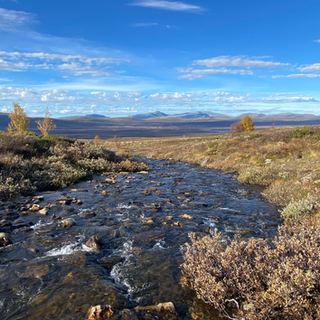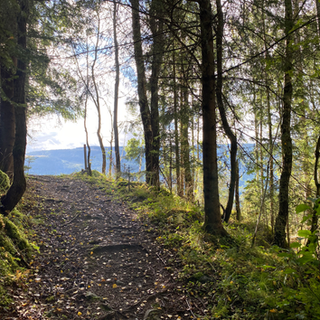
Lillehammer - Trondheim
- 23 days, self-guided -
OVERVIEW
After the death of King Olav in 1030 and his canonization, countless pilgrims travelled to the holy city of Nidaros to pray, give thanks, and seek forgiveness. After the Reformation, the pilgrimage routes fell into disrepair. In the 1980s, restoration began on these historic paths, the most important of which is the Olav Path, or Gudbrandsdalsleden, stretching from Oslo to Trondheim. Today, modern pilgrims follow this route for many reasons – to escape the hectic pace of daily life, to reflect, to seek physical or spiritual challenge, or simply to enjoy nature. Whatever the motivation, this journey becomes much more than just a mountain hike or tourist trail.
The pilgrim trail between Lillehammer and Dovre forms one of the most varied and historically rich sections of the Olav Path. Following the wide Gudbrandsdal valley northward, the route passes traditional farms, medieval churches, quiet birch forests and gentle riverside paths. Along the way, walkers discover cultural landmarks such as Ringebu Stave Church and historic farm settlements that have welcomed travelers for centuries.Y ou will walk from Dovre across the barren Dovrefjell plateau, through beautiful cultural landscapes along the river Orkla, and through forests and marshland before finally reaching Trondheim, where the impressive Nidaros Cathedral awaits
01. Travel day – Overnight in Lillehammer
Stay in a hotel in the city center.
02. Lillehammer – Øyer (ca. 18 km)
The pilgrim trail from the Olympic town of Lillehammer follows a mix of forest paths, rural roads, and some short stretches near traffic as it climbs gradually out of Lillehammer. While not difficult, the walk includes several hills and can be muddy in places after rain.
03. Øyer – Tretten (ca. 19 km)
The hike along the pilgrim trail between Øyer and Tretten is a varied stage that follows a mix of forest paths, gravel farm roads, and stretches through open agricultural landscape. The trail climbs gently out of Øyer before crossing quiet woodland areas, with occasional views back over the Lågen River and the valley.
04. Tretten – Fåvang (ca. 19 km)
Leaving Tretten, the trail first descends, then climbs gently via asphalt roads through farmland and patches of woodland, offering views across the valley and nearby mountains. The terrain is mostly moderate, though some sections can be uneven, especially the first part through the forest. The E6 is, however, never far away.
05. Fåvang – Ringebu (ca. 13 km)
This shorter section through the heart of Gudbrandsdalen passes lush forests, riversides, and open farmland, with stunning cliff views of the valley and surrounding mountains. The stage culminates at Ringebu Stave Church, a historic wooden church dating back to the 13th century.
06. Ringebu – Sør-Fron (ca. 18 km)
Along the way, walkers traverse gentle farmland and forested paths, enjoying expansive valley views. A must-visit is the Dale-Gudbrand Pilgrim Center, where pilgrims can rest, learn about the history of the route, and experience Norwegian cultural heritage. From there, it is an easy walk to Sør-Fron.
07. Sør-Fron – Kvam (ca. 23 km)
A fairly tough hike that includes a mix of quiet country roads, forest paths, and suburban areas. Hikers pass working farms and small villages, and must tackle some steep ascents over occasionally muddy trails.
08. Kvam – Otta (ca. 22 km)
The hike from Kvam to Otta is a more challenging stage of the Olav Path, featuring three significant climbs along the way. The trail winds through the Gudbrandsdalen valley, alternating between quiet country roads, forested paths, and riverside sections, with expansive views of farmland, villages, and surrounding mountains.
09. Otta – Nord-Sel (ca. 17 km)
The first 4 km run parallel to the E6. After Sel, you get your first view of the mountains above the tree line. You follow the valley and the river, which has small, hidden beaches ideal for a picnic.
10. Nord-Sel – Dovre (ca. 26 km)
After a short hike through the village, you reach a fairly rough forest path with quite a bit of climbing and some sliding, high above the river. Later, the paths widen, but there is still some climbing and descending.
11. Dovre – Fokstugu (ca. 16 km)
Here starts your ascent of Dovrefjell. On the open plateau, the wind and weather shape the landscape. You follow the old King’s Road to today’s highest point, Allmannrøysa (1,210 m). For centuries, travellers placed a stone here, but as the road is now protected, adding stones is no longer allowed. From the cairn, a gentle 6 km descent leads you to Fokstugu Fjellstue.
12. Fokstugu – Hjerkinn (ca. 25 km)
You cross the E6 highway and follow the river Foksåa through the quiet Foksådal valley. The path first takes you above the tree line, then continues through birch forests. You will enjoy panoramic views of Dovrefjell and the famous Fokstumyra Nature Reserve, Norway’s most important bird sanctuary.
13. Hjerkinn – Kongsvold (ca. 12 km)
A shorter stage allowing time to explore Hjerkinn and visit the Eystein church. You follow the King’s Road across Hjerkinnhø, reaching a viewpoint at 1,288 meters with sweeping views toward Snøhetta and the Rondane mountains. Y
14. Travel day - Overnight in Oppdal
A travel and rest day. Take the train from Kongsvoll to Oppdal. Depending on the schedule, you may visit Oppdal Church or explore the town center.
15. Oppdal – Havdal (ca. 27 km)
You leave Oppdal behind for a long hike and walk through gently rolling farmland and forest, surrounded by mountains. The route follows typical grusveier (gravel farm roads), interspersed with grass paths. There are frequent views across the wide valley.
16. Havdal – Stamnan (ca. 16 km)
You continue through the beautiful Orkla Valley. The river winds through a cultural landscape of scattered farms and pine-covered hills. After crossing the river at Skjepphaugen, you can choose between a steep path with wide views or an easier route along the riverbank.
17. Stamnan – Rennebu (ca. 14 km)
You walk through forest terrain to reach Rennebu. After a short stretch along road 700, the trail climbs into the hills again and passes several traditional trønderlån – typical long farmhouses from the Trøndelag region.
18. Rennebu – Meldal (ca. 18 km)
This scenic stage winds through quiet woodland, pastureland and along stretches of the Orkla River, combining natural beauty with local cultural heritage. The path is well-marked and moderately easy.
19. Meldal – Gumdalen (ca. 19 km)
A peaceful stage through classic Trøndelag countryside. You pass the historic mining village of Løkken Verk before reaching your farm accommodation in Gumdalen.
20. Gumdalen – Skaun (ca. 21 km)
After passing Lake Solsjøen and Korslia Farm, you reach a cosy pilgrim shelter known as "the living room" – a perfect rest stop. The route continues through quiet peatland, once used only in summer by pilgrims.
21. Skaun – Øysand (ca. 18 km)
The milestone in Skaun reminds you that only 38 km remain to Nidaros Cathedral. You first pass the historic farm of Husaby before walking through farmland toward the river Gaula and Øysand.
22. Øysand – Trondheim (ca. 24 km)
The final stage includes a short but steep climb before continuing through forest and then into Trondheim. Your pilgrimage ends at the majestic Nidaros Cathedral, the spiritual heart of Norway.
23. Travel day
Extra nights in Trondheim may be booked on request.
Optional
Instead of taking the train from Kongsvold to Oppdal, you can hike to Ryphusan via the historic and quite tough Vårstigen. The trail includes a steep climb to Tingsvaet with rewarding views, then continues through forest and into the Vinstra Valley. Please note: there is no running water at Ryphusan, the accommodation is first-come, first-served (we cannot book it for you), and bed linen is not provided (bring your own or we can arrange it). From Kongsvold to Ryphusan it is 22 km; from Ryphusan to Oppdal 28 km.
Summary
-
Self-guided hike along the Olav Path, from Lillehammer to Trondheim (Norway)
-
Ca. 415 km
-
Available from June to September
-
23 days, with an average of 19 kilometers per day.
-
Price coming soon!









